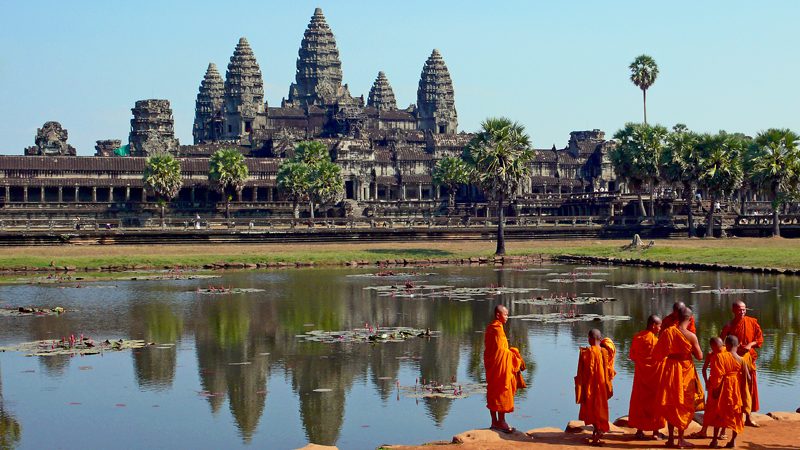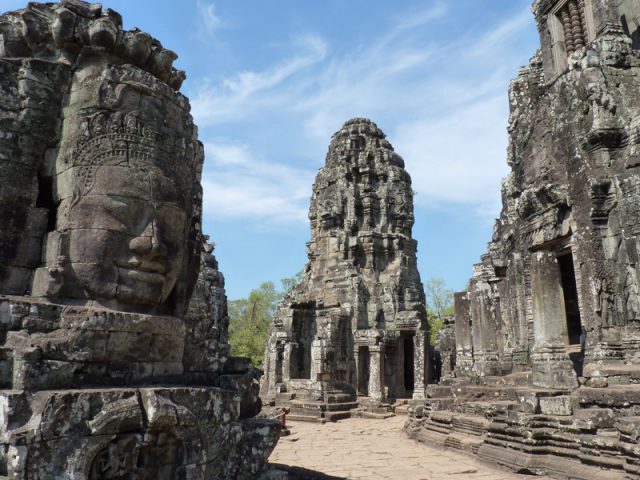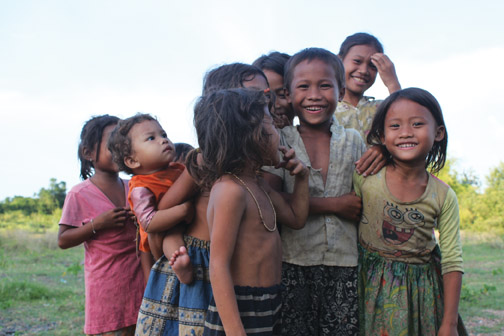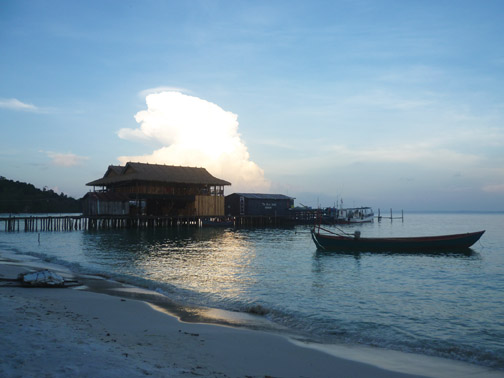“Same same but different!” laughs the young tuk-tuk driver, quoting Southeast Asia’s funny standard phrase, when I took a closer look at the colorful rainbow sign at the back of the cabin. The rainbow advertised a gay bar, an indication of what today‘s Cambodia has to offer gay and lesbian tourists. Thirty-four years after the Khmer Rouge regime killed almost a quarter of the population in a cruel genocide, the “warm heart” of Southeast Asia is finally emerging.
The Kingdom of Cambodia borders Thailand, Laos, Vietnam and the Gulf of Thailand, and possesses a rich and fascinating history. The famous temple city of Angkor was once the capital of the Khmer empire in the 12th century; now the jungle-covered spot is a UNESCO World Heritage Site.
Phnom Penh—“The Charming City“—is signified with a huge, kitschy neon sign on a dusty, congested street in the center of the capital. In the 19th century, Phnom Penh was a flourishing French colonial city, but by 1975 the capital was empty. The reign of the Khmer Rouge turned it into a ghost town, and its infrastructure and cultural life was destroyed. The leader of the communist regime pursued the absurd dream of a completely agricultural society and executed those who did not agree. It has been a long and bumpy road to get to the up-and-coming metropolis Phnom Penh is today.
As you cross the border into Cambodia, one can immediately sense how closely happiness and bitterness, poverty and courtesy, beauty and dirt coexist. Cambodia’s biggest treasure is its people: warm and welcoming, their indomitable spirit is an inspiring contrast to what one could expect after a relatively recent, horrific genocide.
The Gay Scene
While Cambodia lay in ruins, its neighbor Thailand positioned itself as both Southeast Asia’s tourist hub and world-reknowned gay destination. While Cambodia still lacks some modern amenities you’d easily find in Thailand, it offers a more adventurous travel experience that is worth every outhouse with which you’ll have to improvise.
Cambodian society is generally tolerant of homosexuality, and foreigners won’t face anti-gay reactions. Tourists of all sexual orientations should avoid public displays of affection, though; they’re a reminder of the Khmer Rouge’s belief that love and intimacy were a distraction from the dictates of labor.
Among Khmer culture, however, homosexuality is viewed differently: the social pressure to marry and have a family is still high. In a society that favors men, women have limited options for financial independence and a life without a husband. In rural areas the isolation of lesbians can occur, especially when a person does not look traditionally feminine. Many Cambodian lesbians identify either as male or as a third gender. It is common for them to completely adopt a male gender role, wear masculine clothes and use male pronouns. “Toms,” as most butch lesbians call themselves, are on top, while their feminine “Dee” girlfriends are passive. Toms are determined to hide the fact that they aren‘t “real men:“ They never take their clothes off with an intimate partner. If you ever end up with a Tom in the bedroom, don’t be surprised if she refuses your advances!
Homosexuality is not illegal in the kingdom, but Khmer LGBT people are still lacking public protection laws. It is a public secret that Cambodia’s King Sihamoni, a former ballet dancer who has never been married, is gay. “He loves women as his sisters,“ explained his father, the popular former King Norodom Sihanouk (who died in 2012). He had publicly expressed his respect for homosexuals and had declared his support for same-sex marriage. “It’s not their fault if God makes them born like that. […] Gays and lesbians would not exist if God did not create them,” Sihanouk wrote on his website.
Inspired by a TV discussion on International Human Rights Day last year, Prime Minister Hun Sen urged the nation’s people not to discriminate against their homosexual countrymen and -women. In 2007, however, he had disowned his youngest daughter because she married a woman. “We sent her to study in the U.S., but she did a bad job. She returned home and took a wife,” he said. “I’m quite disappointed.”
Cambodia’s gay scene is growing and it’s no longer rare to see lesbian couples in public. The country’s first LGBT Pride Parade was held in 2003, and in 2009 it expanded into a two-week long Pride celebration. In 2011 it featured a Buddhist blessing ceremony, an important achievement in a country where Buddhist teachings still guide people’s beliefs. The next Gay Pride Parade will be held in May 2013.
Must-do Adventures
The best way to get a feeling for this country is by renting a bicycle or motorbike and following your bliss. Feel the wind in your hair while riding along lush green rice paddies as friendly farmers harvest rice crops and water buffalos take a muddy bath. Notice the naked children jumping into rivers and happily dancing in the rain. Enjoy the beauty of the countryside, buy fruits you have never eaten before—wherever you go you will be surrounded by smiling people. Inside the colorful temples, feel free to strike up a conversation with the young monks—they’re eager to practice English and will happily tell about Buddhist teachings and their lives in the monastery. Let your surroundings guide you and you’ll discover more than with any organized tour.
Many travelers just head for a quick visit over the border from Thailand to see the magnificent ancient temple city of Angkor (whc.unesco.org/en/list/668), a treasure of mysterious ruins known all over the world. What brings visitors to the remote site in northwest Cambodia? Many seek to view the world’s largest religious monument Angkor Wat, and Ta Prohm, a temple complex partly overtaken by jungle where sexy fictional archeologist Lara Croft, played by Angelina Jolie, wrestled her way around the famous “city of temples” in Tomb Raider.
Have a closer look, as a ladyloving traveler, when wandering through the temple complex of the Khmer Empire. You will discover that feminine power dominated the ancient city. Female spirits called Apsara dance across the ruins, scantily dressed and engraved in stone, showing their bare breasts (which haven’t sagged a bit in the last 900 years).
Relaxed Siem Reap, about 200 miles northwest of Phnom Penh, serves as the gateway town to Angkor. Many hotels, guesthouses, bars, shops and restaurants create a beneficial counterbalance after a steamy day exploring the ruins. A $5 massage will be the perfect remedy for your sore muscles.
Battambang, a quiet town with an interesting art scene about three hours by public bus west of Siem Reap, features preserved French colonial architecture and atmospheric cafés. Time your visit to see the spectacular circus show of the Phare Ponleu Selpak School (phareps.org). Muscular acrobats climb, jump and balance; a cute girl-on-girl-kiss was the happy ending of the performance I saw.
Float down the Mekong river near Kratie, northeast of Phnom Penh, to watch the rare sweetwater dolphins. It’s hard to imagine that there are actually dolphins living in this opaque brown water! Adventurous travelers also head to the mountainous provinces of Mondulkiri and Ratanakiri to go hiking in the country’s wild and less-touristy northeast.
Nearer to Phnom Penh, no one should miss a visit to the infamous Choeung Ek Killing Fields (phnompenh.gov.kh/phnom-penh-city-choeung-ek-memorial-139.html). Nine miles outside of the capital, you can wander silently among the mass graves and listen to the excellent free audiotour, which is available in many languages. This open air museum is a very intense experience and the best way to learn of the horrors of the Khmer Rouge regime and Cambodian genocide. Combine your day trip with tour through the Tuol Sleng Genocide Museum (phnompenh.gov.kh/ phnom-penh-city-toul-sleng-genocide-museum-140.html), a former high school, which was used as the notorious S-21 Security Prison in the 1970s.
Avoid staying in the bustling port of Sihanoukville, a dirty snakepit filled with drugs, sex tourists and aggressive street vendors. Instead, head to the island of Ko Rong about two-and-a-half hours by boat from the mainland, to swim in crystal clear water and play on white sandy beaches. A few years ago Ko Rong was a secret, but now it is the most happening and fast-developing spot in Cambodia. This stunning paradise can be the highlight of your trip. Hike to the other side of the island to rest on the wonderfully empty “7km white beach,” watch the red, pink and orange sunset and catch a boat back. Book a boat tour with Frank from Aka’s Guesthouse (Koh Tui Beach, +855(0)15 703805), who knows the island like no other. He will take you to traditional fishing villages, fishing nooks or snorkeling to the “Corner Bar” dive spot, and serve you delicious BBQ after dark. A recently opened bar-shack with a “gay bar“ sign might also be worth checking out on Ko Rong.
Where to Stay and Eat
The gay-friendly Golden Banana in Siem Reap (at Phum Wat Damnak, opposite HipHop Club, golden-banana.com) offers a bed-and-breakfast and superior rooms for less than $65 in the high season. Both are connected through a nice pool area in an environmentally friendly building. The owner, Kee Peung, was raised as an orphan refugee in New Zealand after his family was killed at the Killing Fields in the reign of terror. When he returned to Cambodia he made it his policy to help young underprivileged men and women from distant provinces, who are employed on the basis of their willingness to learn and improve their standard of living. Guests are encouraged to talk to the staff about their backgrounds.
The Manor House (21, Str. 262; manorhousecambodia.com), a “gay/straight-friendly” boutique hotel for guests over 18 years old, is your address in Phnom Penh. All rooms have TVs with DVD players, a minibar and access to the pool area. Their tuk-tuk-drivers know about the gay scene, too. Rooms go for $55 or less per night.
Compared with Thai or Vietnamese food, Cambodian food is less dazzling to Western palates. Vegetarians eat rice with vegetables, or noodles with vegetables. Omnivores ingest meat on bones, insects, frogs or even grilled tarantulas! Get up early to mix with the locals at small foodstalls and crowded markets, where the smell of ginger, garlic, coriander and beef broth will make your mouth water and the aroma of a steaming bowl of noodle soup, the traditional breakfast for Cambodians, will set your taste buds alight.
The best coffee in Phnom Penh—Cambodia is definitely not famous for its coffee, note—can be found at the western-style coffeeshop Cafe Fresco (corner of St. 51 and St. 306, cafefresco.net). The picturesque Cafe Eden (85, Group 5, cafeedencambodia.com/main) in Battambang invites visitors to have a rest and serves delicious coffee and snacks.
Friends (#215 St 13, near the National Museum, tree-alliance.org) in Phnom Penh, a training restaurant that teaches former street children skills for a career in the food and drink business, serves tasty tapas and supports a good cause.
Gay Guide
Like most international destinations, the Cambodian gay scene has more to offer for gay men than for women, but a couple of gay bars where lesbians linger are worth a visit.
The Blue Chilli (36, St. 178, near the National Museum; bluechillicambodia.com) is one of Phnom Penh’s oldest and most famous gay bars. A mixed crowd packs the place for the drag show every Friday and Saturday. 2 Colours (225, St. 13) is a relatively new lounge bar that used to have ladies’ night on Saturday (perhaps they will again). Rainbow Bar (Shop 134, St. 136) hosts karaoke, drag and R&B nights and woos the gay crowd with special drink offers. The famous nightclub Pontoon (80, St. 172; pontoonclub.com) hosts Shameless, a weekly gay night, on Thursdays.
In Siem Reap you might find other lesbians at Linga Bar (near the Old Market; lingabar.com), a stylish lounge with comfortable seats and occasional Ladyboy shows. Get a “taste of vintage Shanghai” at the gay-friendly Miss Wong Cocktail Bar (The Lane, between 7th and 8th Streets; misswong.net). HipHop Club (near Phum Wat Damnak) is a happening hangout for the local youth, with some being girls who love girls.
Get Going
Cambodia is a booming travel destination in Asia. Travelers from all over the world are finding the charm, beauty and history that lie within its borders. Cambodia’s growing gay scene is another reason visitors are drawn to this mesmerizing country. The biggest lure, however, must be Cambodians themselves, the world’s warmest people, who are doing what they can to welcome everyone: those who are same same and those who are different.










What Do You Think?